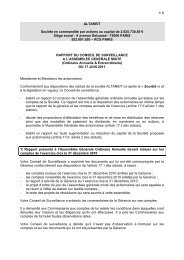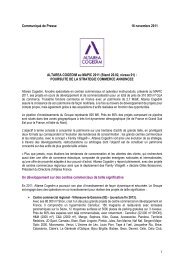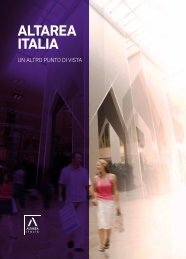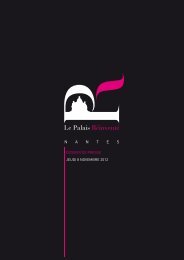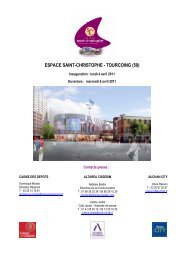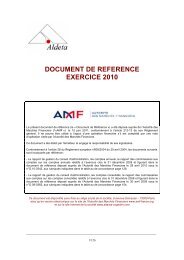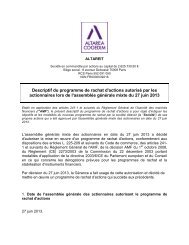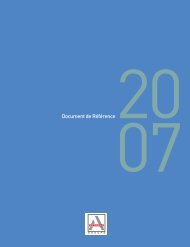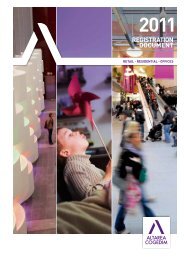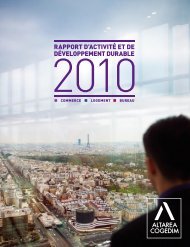Annual report 2008 - Altarea Cogedim
Annual report 2008 - Altarea Cogedim
Annual report 2008 - Altarea Cogedim
Create successful ePaper yourself
Turn your PDF publications into a flip-book with our unique Google optimized e-Paper software.
7.3.1. IFRS 8 “Operating Segments”<br />
• Accounting treatment<br />
After adopting IFRS 8 early at 31 December 2007,<br />
the Group reviewed the breakdown of its activities into<br />
operating segments and came to the conclusion that the<br />
activities performed by <strong>Cogedim</strong>, be they residential<br />
property development (predominantly off-plan sales) and<br />
commercial property development (primarily delegated<br />
project management and property development contract<br />
transactions), were conducted on a totally centralised basis<br />
from a decision-making standpoint. Management took the<br />
view that each programme constituted a CGU and that the<br />
group of CGUs formed an operating segment. It was thus<br />
considered that the Property development for third parties<br />
business represented a unique operating segment and<br />
accordingly a decision was made to merge the Residential<br />
Property Development and Commercial Property operating<br />
segments as previously defined. The Residential and<br />
Commercial Property segments now represent product lines<br />
(residential, hotels, offices, large mixed-use urban projects)<br />
broken down by business line (property development,<br />
development for own account and third parties, delegated<br />
project management and marketing).<br />
Management believes that the three characteristics of an<br />
operating segment are satisfied for the third-party property<br />
development as defined below, i.e.:<br />
- an activity generating revenues and incurring expenses,<br />
- Operating profit regularly reviewed by ALTAREA’s<br />
management, which makes resource allocation decisions<br />
and assesses performances,<br />
- Information fully available.<br />
Accordingly, at Group level, management introduced a<br />
change in accounting method based on a reduction in the<br />
number of operating segments to three, that is an owned<br />
shopping centre business, a shopping centre development<br />
business for its own account and the property development<br />
for third parties business.<br />
See note 7.31. “Operating Segments” for a detailed<br />
presentation of these.<br />
• Consequences and impact of the change in accounting<br />
method on the Group’s consolidated financial statements<br />
This change in accounting method was applied<br />
retrospectively.<br />
It did not lead to any impact on the Group’s financial<br />
statements, except for:<br />
– the presentation of the costing-based profitability analysis,<br />
which is presented according to the two analytical axes of<br />
recurring profit and non-recurring profit. Recurring profit<br />
in the costing-based profitability analysis is now analysed<br />
through the contribution made by the two operating<br />
segments, i.e. the owned shopping centre business and<br />
the property development for third parties business.<br />
– The presentation of the balance sheet and profit by<br />
operating segment.<br />
All the quantified figures by operating segment in the notes<br />
to the financial statements have been adjusted in respect of<br />
the two financial years shown.<br />
7.3.2. IAS 36 “Impairment of Assets”<br />
• Accounting treatment<br />
Goodwill and other intangible assets not subject to<br />
amortisation are grouped with other non-current assets<br />
(property, plant and equipment and intangible assets subject<br />
to amortisation) within Cash-Generating Units (CGUs).<br />
A CGU is defined as the smallest identifiable grouping of<br />
assets that generates cash flows independently of the cash<br />
flows generated by other assets or groups of assets.<br />
As stated in note 7.3.1, the Group considers that each<br />
programme represents a CGU, with the group of CGUs being<br />
a single operating segment called “Property development<br />
for third parties”.<br />
At 31 December 2007, goodwill arising from the acquisition<br />
of <strong>Cogedim</strong> was provisionally allocated to three CGUs<br />
representing identified operating segments at the time,<br />
namely,<br />
– shopping centre development,<br />
– residential property development,<br />
– commercial property.<br />
This goodwill was reallocated to several Cash-Generating<br />
Units (groupings of programmes/projects) comprising:<br />
– major urban mixed-use projects within the “shopping<br />
centre development for own account” operating segment,<br />
– all the programmes combined in the “Property development<br />
for third parties” operating segment.<br />
• Consequences and impact of the change in accounting<br />
method on the Group’s consolidated financial statements<br />
The definitive allocation (compared with the provisional<br />
initial allocation) of goodwill arising from the <strong>Cogedim</strong><br />
acquisition was as follows:<br />
(in € thousand)<br />
Property development for third parties<br />
Definitive<br />
allocation<br />
Initial<br />
allocation<br />
240,222<br />
of which Residential Property Development 262,222 122,260<br />
of which Commercial Property Development 117,962<br />
Retail development - GPUM* 89,056 111,056<br />
Total Goodwill - <strong>Cogedim</strong> 351,278 351,278<br />
*Large Urban Mixed-Use Projects<br />
87



